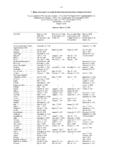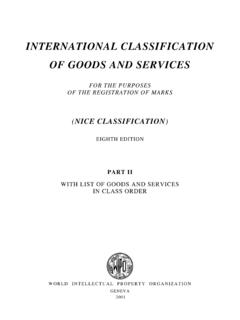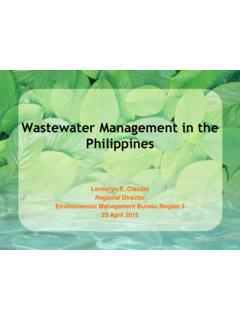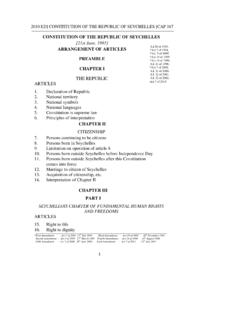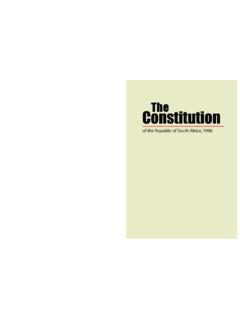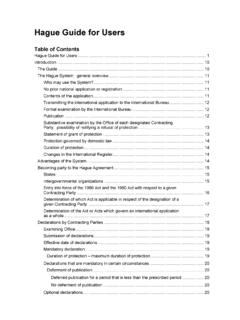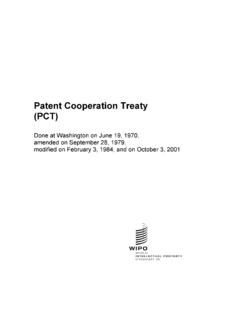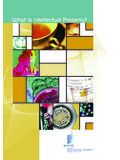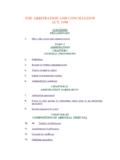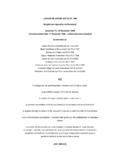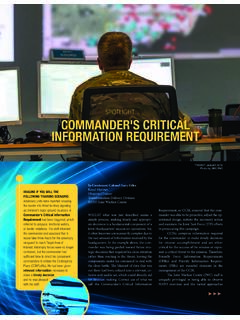Transcription of TECHNOLOGY TRANSFER, INTELLECTUAL PROPERTY AND
1 TECHNOLOGY transfer , INTELLECTUAL PROPERTY AND EFFECTIVE UNIVERSITY-INDUSTRY PARTNERSHIPS The Experience of China, India, Japan, Philippines, the Republic of Korea, Singapore and ThailandFor more information contact theWorld INTELLECTUAL PROPERTY OrganizationAddress:34, chemin des Colombettes Box 18CH-1211 Geneva 20 SwitzerlandTelephone:+41 22 338 91 11 Fax:+41 22 733 54 the WIPO website order from the WIPO Electronic Bookshop its New York Office at:Address: 2, United Nations Plaza Suite 2525 New York, 10017 United States of AmericaTelephone: +1 212 963 6813 Fax: +1 212 963 4801e-mail: Publication no.
2 928 EISBN 978-92-805-1620-3 THE PRESENT STUDY* IS BASED ON RESEARCH** CONDUCTED BY A group OF EXPERTS UNDER THE COORDINATION OF:Mr. Risaburo Nezu, Senior Executive Fellow, Economic Research Center, Fujitsu Research Institute, JapanWITH THE PARTICIPATION OF:Chou Siaw Kiang, Vice-Dean, External and Industry Relations, Faculty of Engineering, National University of Singapore, SingaporePrabuddha Ganguli, Advisor to the Indian Institute of TECHNOLOGY , Mumbai, IndiaKrisnachinda Nithad, Chairman, Industrial TECHNOLOGY Center, King Mongkut s Institute of TECHNOLOGY Ladkrabang, ThailandKoji Nishio, Research Fellow, Economic Research Center, Fujitsu Research Institute, JapanLydia G.
3 Tansinsin, Lecturer, Graduate School on Project Management and TECHNOLOGY Management, University of Santo Tomas,PhilippinesHwa-Chom Yi, Associate Professor, School of Mechanical Engineering, Yeungnam University, Republic of KoreaJia Yujian, Standing Director, National TECHNOLOGY transfer Center, Xi an Jiaotong University, People s Republic of ChinaPROJECT FUNDED BY THE JAPANESE FUND-IN-TRUST* The views expressed in this study are those of the authors and do not necessarily represent those of WIPO.** Each national study is published on the WIPO website ( )928E-CaP:928E-CaP 12:02 Page 2 TECHNOLOGY transfer , INTELLECTUAL PROPERTY AND EFFECTIVE UNIVERSITY-INDUSTRY PARTNERSHIPS The Experience of China, India, Japan, Philippines, the Republic of Korea, Singapore and Thailand2 PREFACEI am pleased to present this study on TECHNOLOGY transfer , INTELLECTUAL PROPERTY Rights and University-IndustryPartnerships.
4 The Experience of China, India, Japan, Philippines, the Republic of Korea, Singapore and worldwide play a leading role in advancing the frontiers of science and TECHNOLOGY . In recentyears, a key concern for policy-makers has been how to ensure that the wealth of knowledge generatedwithin universities can be transferred to industry so that society in general, and local businesses in par-ticular, can benefit from university scientific and technological expertise. The realization that importantresearch results would not reach society as a result of bottlenecks in the commercialization of universi-ty research results led to increasing interest in finding the most adequate frameworks to promote uni-versity-industry partnerships for the transfer of TECHNOLOGY .
5 INTELLECTUAL PROPERTY rights have been identified in many countries as a mechanism that provides the nec-essary incentives for the commercialization of university research results. Data from a number of Asiancountries show a marked increase in the number of patent applications filed by universities. Nationalgovernments have enacted policies to promote university-industry TECHNOLOGY transfer , and various Asianuniversities have adopted formal INTELLECTUAL PROPERTY policies and established TECHNOLOGY transferoffices to manage their INTELLECTUAL PROPERTY rights.
6 The time, therefore, seemed ripe for embarking on ananalysis of university-industry partnerships for TECHNOLOGY transfer in Asia, with a view to identifyingsome of the lessons that may be learned for the future. I would like to express my gratitude to all the researchers who have contributed to this endeavor. I hopethat the study proves to be an effective tool in understanding recent developments in Asia, and will pro-vide useful insights to policy-makers engaged in finding the most effective ways to promote the devel-opment of university-industry IdrisDirector General,WIPO2007 TABLE OF CONTENTSPA RT 1.
7 OVERVIEW OF TECHNOLOGY transfer , INTELLECTUAL PROPERTY RIGHTS AND EFFECTIVE UNIVERSITY-INDUSTRY PARTNERSHIPS IN CHINA, INDIA, JAPAN, PHILIPPINES, THE REPUBLIC OF KOREA, SINGAPORE AND ANDCULTURALSETTINGS FORUNIVERSITY-INDUSTRY(U-I) RELATIONSHIPS:FACTS FORU-I FORMANAGINGINTELLECTUALPROPERTYRIGHTS INU-I ANDORGANIZATIONALSETUP FOR THEMANAGEMENT OFU-I COLLABORATIONANDROLE ANDMECHANISMS FORMANAGINGCONFLICTS OFINTERESTTABLES ANDGRAPHSLIST OFREFERENCESPA RT 2 :DEVELOPING INTELLECTUAL PROPERTY FRAMEWORKS TOFACILITATE UNIVERSITY-INDUSTRY TECHNOLOGY TRANSFERA Checklist of Possible ONINTELLECTUALPROPERTY ONINTELLECTUALPROPERTY ANDPRACTICALASPECTS FORTECHNOLOGYTRANSFER FROMUNIVERSITIES TOINDUSTRYSTRUCTUREDBIBLIOGRAPHY FORFURTHERREADING34591217212529313336384 14446 PART1.
8 OVERVIEW OF TECHNOLOGY transfer , INTELLECTUAL PROPERTY RIGHTSAND EFFECTIVE UNIVERSITY-INDUSTRY PARTNERSHIPS IN CHINA, INDIA, JAPAN,PHILIPPINES, THE REPUBLIC OF KOREA, SINGAPORE AND THAILANDR isaburo study examines and evaluates the recent progress made in seven Asian countries (China, India, Japan, Philippines,the Republic of Korea, Singapore and Thailand) towards more effective and mutually reinforcing relations between uni-versities and industries in the field of scientific and technological research and proposes a checklist for action to makethese relationships even more effective from the broad perspective of the national economy.
9 In particular, it highlights themechanisms adopted by these Asian countries for TECHNOLOGY transfer and pays particular attention to the use of the intel-lectual PROPERTY system as an instrument for TECHNOLOGY transfer from university to industry. While economic and histori-cal situations are different across Asian countries and no simple solution can be found that is universally applicablethroughout the region, it is the hope of the participants in this project that this document will provide some useful les-sons and insights, and will thus be helpful to policy-makers who are concerned with evaluating the effectiveness of uni-versity-industry relations in their respective countries and identifying ways to improve overview chapter draws largely from the national studies commissioned by WIPO2as well as from the discussionsheld at the WIPO Roundtable on Development of University-Industry Partnerships for the Promotion of Innovation and theTransfer of TECHNOLOGY that took place on 26 and 27 April, 2005, in Tokyo.
10 At the Roundtable, it was found that in manycountries, transfer of TECHNOLOGY involves not only universities, but also government-funded laboratories. This paper,however, focuses on the transfer of TECHNOLOGY from universities, since universities have special challenges and institu-tional problems that may not be of direct relevance to national research partnerships in the field of science and TECHNOLOGY are complex and may develop through a large num-ber of mechanisms. These may range from more informal mechanisms, which include publication of research results,employee mobility or informal exchanges between scientists to more formal contractual mechanisms in which longer-term relationships are established.
